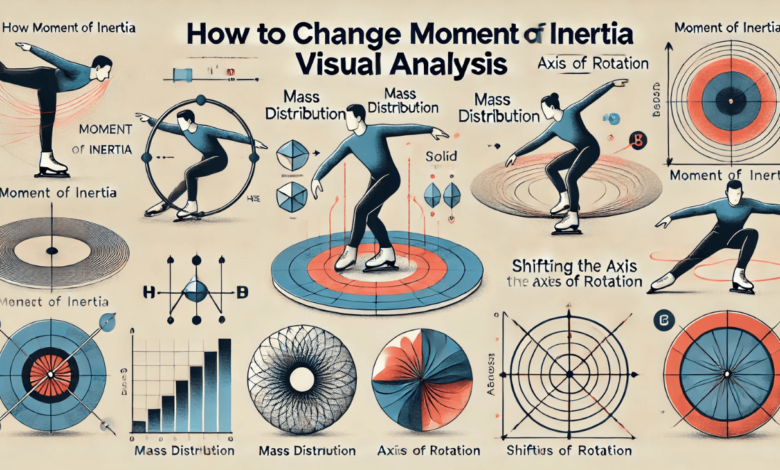How to Change Moment of Inertial Visual Analysis

Understanding and manipulating the moment of inertia is a key concept in rotational dynamics. Whether you’re an engineer, designer, or athlete, being able to change the moment of inertia visually can help you optimize performance or design better systems. But how exactly can you change the moment of inertia, and how to change moment of inertial visual analysis?
In this article, we’ll explore practical ways to change the moment of inertia and the tools you can use for visual analysis. By the end, you will have a clearer understanding of how the moment of inertia can be altered and how to visualize these changes effectively.
What Is Moment of Inertia?
Before diving into the ways to change the moment of inertia, it’s essential to understand what it is. The moment of inertia (I) is a physical property of an object that quantifies its resistance to rotational motion about a specific axis. It is similar to mass in linear motion, but instead, it measures an object’s ability to resist angular acceleration. For example, a rotating disk with more mass at its edge has a higher moment of inertia compared to a disk with mass near its center.
How to Change Moment of Inertia
Changing the moment of inertia is often a critical consideration in applications ranging from mechanical systems to sports. You can adjust an object’s moment of inertia in several ways:
- Redistributing Mass: The simplest way to change the moment of inertia is to change how the mass is distributed relative to the axis of rotation. For instance, when a figure skater pulls in their arms, they reduce the distance between their mass and the axis, thus decreasing their moment of inertia and spinning faster. Conversely, extending their arms increases the moment of inertia, slowing their rotation.
- Shifting the Axis of Rotation: Using the Parallel Axis Theorem, you can shift the axis of rotation and calculate how the moment of inertia changes. This is especially useful when working with objects that are not rotating about their center of mass, such as a rotating beam or a wheel. The moment of inertia about any axis parallel to the center of mass axis can be found by adding the mass times the distance squared to the original moment of inertia.
- Using Different Shapes: The shape of an object plays a significant role in its moment of inertia. A solid disk, hoop, or spherical object all have different moments of inertia even if they have the same mass and radius. For example, a solid disk’s moment of inertia is half of that of a hoop with the same mass and radius. Altering the shape can therefore be a method to change how an object resists rotational motion.
- Changing the Distribution of Materials: In engineering, changing the material distribution within an object can alter its moment of inertia. For instance, in vehicles, moving heavy components like the engine closer to the center can reduce the vehicle’s moment of inertia, improving its handling.
Visual Analysis of Moment of Inertia
Changing the moment of inertia is one thing, but how do you analyze these changes visually? Visual analysis tools are crucial in understanding the effect of these adjustments in real-world applications, especially in industries like engineering, sports, and biomechanics. Here are some tools you can use:
- 3D Modeling Software: Tools like AutoCAD, SolidWorks, or COMSOL Multiphysics can help visualize and simulate changes in moment of inertia. These programs allow you to model objects, adjust their mass distribution, and simulate their rotational behavior. By running simulations, you can instantly see how different designs or changes in shape affect the moment of inertia.
- Motion Capture Technology: In sports and biomechanics, motion capture technology can be used to analyze the moment of inertia of athletes or objects in motion. For example, a diver or gymnast might be tracked using markers placed on their body to determine how changes in posture impact their rotational motion. This method is often used to optimize athletes’ performance by reducing their moment of inertia when necessary.
- Physics Simulations: Software like MATLAB or Python with physics simulation libraries can be used to run simulations that visually show how the moment of inertia changes under different conditions. These simulations can be helpful for understanding complex interactions, such as the movement of rigid bodies in multiple dimensions.
- Experimental Visualization: In some cases, you may need to visualize changes in moment of inertia through physical experiments. Using high-speed cameras or sensors, you can track how an object’s rotation changes when its moment of inertia is modified. For example, rotating a cylinder or disk while varying the distribution of mass and observing the changes in angular velocity is an effective way to analyze the visual impact of changing the moment of inertia.
Real-World Applications of Moment of Inertia and Visual Analysis
Understanding how to change the moment of inertia and visually analyze these changes has real-world implications in various fields.
- Sports: Athletes frequently manipulate their moment of inertia to enhance performance. A figure skater, for instance, pulls in their arms to spin faster by decreasing their moment of inertia. Similarly, divers adjust their posture to control their speed and positioning during a dive. Visual analysis tools are used to track these changes and refine performance.
- Engineering and Manufacturing: In mechanical systems, optimizing the moment of inertia can lead to more efficient machinery. For example, in the design of flywheels or engines, engineers use visual analysis to adjust the distribution of mass and minimize energy loss due to rotational inertia. By applying simulations and visual analysis tools, engineers can create more efficient and powerful systems.
- Vehicle Dynamics: The moment of inertia also plays a crucial role in vehicle handling. Reducing the moment of inertia can improve vehicle stability and handling by making the car’s rotation more responsive. Engineers use software to visualize how adjustments to mass distribution or changes in wheel design can influence the overall dynamics of the vehicle.
- Robotics: In robotics, controlling the moment of inertia is essential for creating efficient and responsive machines. Robots often need to manipulate objects or navigate complex environments where changing the moment of inertia can help optimize their movement. Visual analysis tools help engineers and designers fine-tune robotic performance.
Conclusion
In conclusion, changing the moment of inertia is an essential technique in various fields ranging from sports to engineering. By redistributing mass, changing the axis of rotation, or adjusting the object’s shape, we can effectively alter its moment of inertia. To visually analyze these changes, we rely on advanced tools like 3D modeling software, motion capture technology, and physics simulations. By mastering how to change moment of inertial visual analysis, professionals across many industries can achieve more precise control over rotational dynamics, ultimately improving performance and efficiency.
Understanding and applying these concepts will not only help you manipulate the moment of inertia but also enhance your ability to visualize and optimize systems for a wide range of applications.



